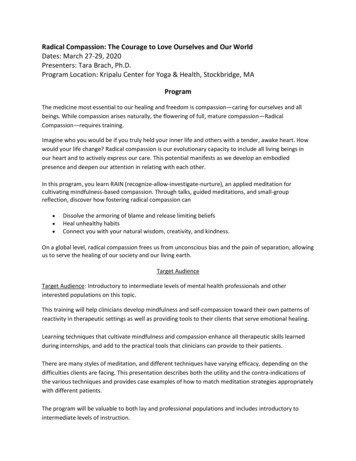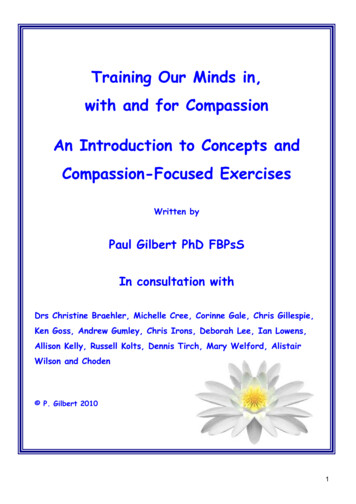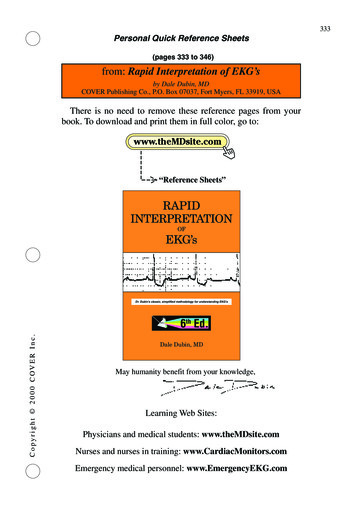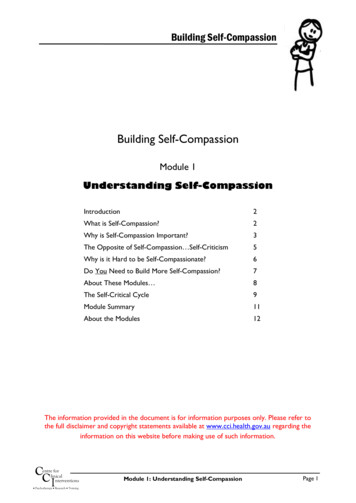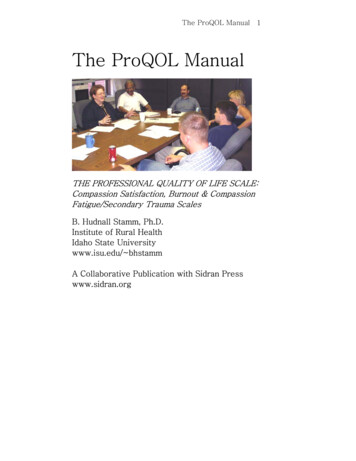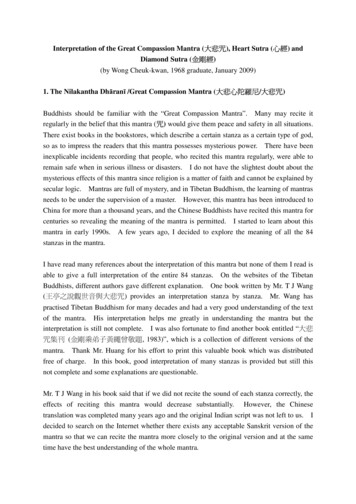
Transcription
Interpretation of the Great Compassion Mantra (大悲咒大悲咒),心經)大悲咒 Heart Sutra (心經心經 andDiamond Sutra (金剛經金剛經)金剛經(by Wong Cheuk-kwan, 1968 graduate, January 2009)1. The Nilakantha Dhāranī /Great Compassion Mantra 悲心陀羅尼 大悲咒)大悲咒Buddhists should be familiar with the “Great Compassion Mantra”. Many may recite itregularly in the belief that this mantra (咒咒) would give them peace and safety in all situations.There exist books in the bookstores, which describe a certain stanza as a certain type of god,so as to impress the readers that this mantra possesses mysterious power. There have beeninexplicable incidents recording that people, who recited this mantra regularly, were able toremain safe when in serious illness or disasters. I do not have the slightest doubt about themysterious effects of this mantra since religion is a matter of faith and cannot be explained bysecular logic. Mantras are full of mystery, and in Tibetan Buddhism, the learning of mantrasneeds to be under the supervision of a master. However, this mantra has been introduced toChina for more than a thousand years, and the Chinese Buddhists have recited this mantra forcenturies so revealing the meaning of the mantra is permitted. I started to learn about thismantra in early 1990s.stanzas in the mantra.A few years ago, I decided to explore the meaning of all the 84I have read many references about the interpretation of this mantra but none of them I read isable to give a full interpretation of the entire 84 stanzas. On the websites of the TibetanBuddhists, different authors gave different explanation. One book written by Mr. T J Wang(王亭之說觀世音與大悲咒) provides an interpretation stanza by stanza. Mr. Wang haspractised Tibetan Buddhism for many decades and had a very good understanding of the textof the mantra. His interpretation helps me greatly in understanding the mantra but theinterpretation is still not complete. I was also fortunate to find another book entitled “大悲咒集刊 (金剛乘弟子黃繩曾敬題, 1983)”, which is a collection of different versions of themantra. Thank Mr. Huang for his effort to print this valuable book which was distributedfree of charge. In this book, good interpretation of many stanzas is provided but still thisnot complete and some explanations are questionable.Mr. T J Wang in his book said that if we did not recite the sound of each stanza correctly, theeffects of reciting this mantra would decrease substantially. However, the Chinesetranslation was completed many years ago and the original Indian script was not left to us. Idecided to search on the Internet whether there exists any acceptable Sanskrit version of themantra so that we can recite the mantra more closely to the original version and at the sametime have the best understanding of the whole mantra.
I am very fortunate to have found from this website an article by an Indian scholar Mr.Lokesh Chandra entitled “Origin of the Avalokitesvara of Potala”: h 07 01 01.pdf). This article records hiswork of studying various versions of the text written in ancient Indian script and his proposedreconstructed Sanskrit text together with explanation in English. The explanation in English,though not provided stanza by stanza, is quite inspiring since it bridges the gap found in otherreferences. I am able to interpret the mantra stanza by stanza based on his work and thereferences mentioned above. In order to help ordinary readers understand the mantra stanzaby stanza in both Chinese and English, I have depicted the mantra in the form of a table (ref.Appendix A) with explanation in both Chinese and English. To suit the Sanskrit textreconstructed by Mr. Chandra, I have amended the Chinese text slightly. After reciting therevised text for some months, I have found no difficulty in reciting the reconstructed Sanskritand Chinese text. Moreover, with the explanation in both Chinese and English for eachstanza, it is be easier for readers to understand the blessings of Avalokitesvara (聖觀自在菩薩) to all beings. Reciting the mantra will help all beings (一切眾生) to be liberated fromfears, vexations and attachments to desires, and become adored to the Triple Gem ‘TheBuddha, Dharma ad Monks (皈依三寶 : 佛、法、僧)’.Mr. Lokesh Chandra’s autobiography is given at the website of Wikpedia(http://en.wikipedia.org/wiki/Lokesh Chandra). Lokesh Chandra is a contemporary scholarof Buddhism and the Indian arts. He is the son of the famous Sanskrit scholar Raghu Vira.He has also served as a member of the Indian Rajya Sabha besides serving as aVice-President of the Indian Council for Cultural Relations, and Chairman of the IndianCouncil of Historical Research. In 2006, he was recognized with India's Padma Bhushanaward. He has to his credit over 360 works and text editions. Among them are classics likehis "Tibetan-Sanskrit Dictionary", "Materials for a History of Tibetan Literature", "BuddhistIconography of Tibet", and his "Dictionary of Buddhist Art" in about 20 volumes. Presently,he is Director, International Academy of Indian Culture. He is acknowledged as one of thegreat cultural giants of India. Therefore, I consider that his article “Origin of theAvalokitesvara of Potala” can be trusted.The Great Compassion Mantra was translated into Chinese by Vajrabodhi (金剛智) (workedA.D. 719-741), twice by his disciple Amoghavajra (不空) (worked A.D. 723-774) and in the14th century by Dhyanabhadra (指空) (worked A.D. 1326 – 13636). The most popularChinese version read by Buddhists nowadays is that translated by Vajrabodhi (金剛智).According to Mr. Huang’s book on collection of different versions of the Great CompassionMantra “大悲咒集刊 (金剛乘弟子黃繩曾敬題)”, the Buddha talked about this mantra to2
several gods and bodhisavattas in the earthly paradise of Avalokitesvara (聖觀自在菩薩) atMount Potala (普陀山).The Buddha told Avalokitesvara to take hold of this mantra so thatthe beings in the future wicked world could be benefited. Avalokitesvara took over thismantra and swore that all beings who recited this mantra constantly would attainenlightenment and superb merits. The Buddha gave this mantra a name as “NilakanthaDhāranī (大悲心陀羅尼)”. Later, it was given a secular name as the “Great CompassionMantra (大悲咒). What is the difference between “dhāranī (陀羅尼)” and “mantra”? Adhāranī is a type of ritual speech similar to a mantra. The word “dharani” derives from aSanskrit root dh.r which means to hold, or maintain ��意思).The distinction between “dhāranī” and “mantra” is a difficult one to make.Wecan say that all mantras are dhāranīs but that not necessarily all dhāranīs are mantras.Mantras are generally shorter.Where is Mount Potala?Mr. Chandra opined that Mount Potala was located at South India(please refer to the first paragraph if his article). At present, Chinese Buddhists took MountPotala to be Mountain Putuo (普陀山) at Chekiang Province (浙江省). Please visithttp://baike.baidu.com/view/22247.htm ,是觀世音菩薩的道場。 普陀山(Mountain Putuo)是舟山群島 1390 �面積近 13 2007 年 5 月 8 �旅遊局正式批准,爲國家 5A ��神秘,成爲馳譽中外的旅遊勝地。)2. The Great Wisdom Beyond Wisdom Heart Sutra /Heart Sutra �� 多心經 /心經心經)心經I have attained some degree of enlightenment of the Heart Sutra after learning it foryears. This sutra is very difficult to understand, so it is my wish to produce a simpleexplanation for the readers for their daily practice. Up to the present level of myunderstanding based on the Middle Way Buddhism, I have attempted to write down theexplanation in a simple format. The purpose is to help ordinary readers to appreciatethe meaning of “Emptiness” this abstruse sutra and practice the six forms of PrajnaParamita (i.e. charity, self-discipline, forbearance, diligence, Zen meditation, andtranscendental wisdom) to free from all suffering in life.3It is at Appendix B.
3. The Diamond-Cutter of Perfect Wisdom Sutra/Diamond Sutra 剛經金剛經)蜜多經金剛經Since this sutra is very long, I have attempted to produce a condensed version of around 270words in the same way as the previous masters condensed the 800 volumes of the GreatPrajna Paramita Sutra (大般若經) into a simple “Heart Sutra” of 260 words, summarizing thecentral meaning of the sutra. Based on my understanding, I have written down theexplanation in a simple format to facilitate ordinary readers. As attachments (執著) are thehardest things of our mind, we may need this sutra to help us cut away our attachments like adiamond cutter is used to cut the hard materials.4It is at Appendix C.
Appendix ANilakantha Dhāranī1 / The Great Compassion Mantra �解釋2by Lokesh ChandraEnglish Translationby Lokesh Chandra1. 南無 怛那-哆囉夜耶/.2-3. Namo ārya valokiteśvarāya2. 南無 阿唎耶 3. 婆盧羯帝.爍缽囉 2-6. 皈依大悲聖觀自在菩薩大菩薩。4. bodhisattvāya耶. 4. ��切鬼卒的侵害,皈 Avalokitesvara, 4.bodhisattva, 5.5. mahāsattvāya5. �請說廣大圓滿無礙大悲 mahasattva, 6. the Great Compassionate6. mahākārun ikāya/6. 7. Om / 8-9.sarva-bhaya-sodhanaya7. 唵/ 8-9. 薩皤-巴哈耶-數怛那耶7-9. 怛寫.聖眾。7-9. Om, Having paid adoration to Onewho Dispels all Fears,10. namaskr tva imụ10. 南無士傑他 伊蒙.11. 阿唎耶 佛 10-11. 皈依彼海島香山聖觀自在菩薩。11. Aryavalokiteśvarāya12. namo Nilakantha/1tava囉傑爹梳囉耶 他華.12. 南無.那囉謹打.1. 皈依三寶 (佛、法、僧)。1. Adoration to the Triple Gem (Buddha,Dharama and Monks).1. Namo Ratna-trayāya/12. 皈依於彼聖觀自在賢愛大悲心。2-3. Adoration to the noble10-11. O noble Avalokiteśvarā, to Youadoration,12 O NilakanthaA dhāranī (陀羅尼) is a type of ritual speech similar to a mantra. The word dharani derives from a Sanskrit root dh.r which means to hold, or maintain ��意思). The distinction between dharani and mantra is a difficult one to make. We can say that all mantras are dharanis but that not necessarily all dharanis are mantras.Mantras are generally shorter.2The essay entitled “ Origin of the Avalokitesvara of Potala” is posted on the website: - http://www.thdl.org/texts/reprints/kailash/kailash 07 01 01.pdfMr. Lokesh Chandra of New Dehi is a contemporary scholar of Buddhism and the Indian arts: http://en.wikipedia.org/wiki/Lokesh Chandra.
15. ajeyam 16-17. sarva-bhutanam13- 17. Shall enunciate the ‘heart’ dharaniwhich ensure all purposes,沙他南 �等廣大無 is pure and invincible for all beings, andwhich purifies the path of existence.15. 阿逝孕.16. 薩婆-菩哆藍 巴話- am//摩伽-.17. 威蘇德禽.18. Tadyathā/18. 怛姪他/.18. 即說此真言曰:19. Om /19. 唵/.阿盧迦帝怕帝.19. 皈依有光明智慧者、20-21. lokatikranta/20-21.盧迦帝關他/.20. 觀自在、21.超越世間者。22. ehy- [ehi] 23. mahābodhisattva22. 夷醯唎.23. 摩訶菩提薩埵22. 請 請 23-24.大菩薩 ,24. sarpa-sarpa/24. 薩婆薩婆/.25. 醯摩囉/醯摩囉24. 請來 請來。26. 馱孕.25-26. 憶念憶念大悲心陀羅尼真言,27. 俱盧-俱盧 羯蒙27. 所作及所作業淨。13. hrdayam vartayisyami14. sarvartha – śadhanam subham/Aalokadhipati25. smara/smara26. hrdayam/ 27. kuru-kuru karma/13. 哆孕 皤他衣沙咩.14. 薩婆阿他- 13- 17. 將釋出大悲心陀羅尼給一切眾18. Om,19-20. Adoration to the Lord ofEffulgence, 21. the Word-transcendingOne.22-23. Come, come, great bodhisattva,24. descend, descend.25-26. Bear in mind my heart-dharani.26. Do the work.28. dhuru-dhuru vijayate28. 度盧-度盧 罰闍耶帝. 29. 摩訶- 28. 保持保持 所有勝願、29. 及大勝願。 28. Hold fast, oh Victor, oh Great Victor29. maha-vijayate/罰闍耶帝.30. 持大悲心陀羅尼真言者,30. dhara-dhara 31-32. dharani-rāja/30. 陀囉-陀囉.31. 地唎尼-31-32. 堅持、堅持。32. 囉喳630-32. Hold on, hold on, oh Lord of theDharani.
33 cala-cala 34. mama vimala- 35.murtte,36. ehi-ehi/ 37. chinda-chinda/ 38.arsa pracali/ 39. visam-visam40. pranasaya/41. hulu-hulu smara 42. hulu-hulu/43-44.sārā- sārā siri-siri 45. surusuru/ 46. bodhiyā-bodhiyā47. bodhaya-bodhaya/33. 遮囉-遮囉.34. 摩麼罰摩囉-35. 33. 行動 行動 34. 令我離慾而得解脫, 33-34. Move, move, to my immaculateliberation. 35. The adamantine king of穆帝隸.35. 統治和平的法王,awakening. 36-40. Pledge, pledge.36. 伊醯-伊醯.36. 請來完我弘誓。Destroy every poison.37. 室打-室打.38. 阿沙 拍囉卡利. 37. 奉請奉請, 38-40. 聖眾佛菩薩, 不38-40. Not translated by the author.39. 罰參-罰參.40. -47. Quick, bear in mind, quick, quick.41. 呼嚧-呼嚧 醯摩囉 .42. 呼嚧-呼 41-47. 速疾速疾,感應直達蓮花部覺者 Descend, descend. Being enlightened,being enlightened enlighten, enlighten嚧 43. 娑囉-娑囉.44. 悉唎-悉唎. (菩薩)、圓覺者 (佛陀)。me.45.蘇嚧蘇嚧/. 46. 一切恐怖危難。)48. maitrīya 49. Nilakantha50-51. darsanam/Prahārayamānaya52.svāhā/ 53-54 . siddhāya svāhā/55-56 mahāsiddhāya svāhā/48. 彌帝唎夜.49. 那囉謹打48-49. 有賢愛慈悲之心的地獄救度者。50. 打瑟南/. 51. 波哈那夜摩那夜. 50-52.請即現前 令生歡喜。52. 娑婆訶.53. 悉陀夜.54. 娑婆訶.53-54.成就者,吉祥。55. 摩訶悉陀夜.56. 娑婆訶.55-56. 大成就者,吉祥。748-52. Oh merciful Nilakantha appearunto me.50-52. To You who eyes us, hail.53-54. To the Great Siddha , hail.
57-59 siddhayogiśvarāya svāhā/60-61 Nilakanthaya svāhā/62-63 varaha-mukhaya svaha/64-65 narashimha-mukhaya svaha/66-67 gada-hastaya svaha/68-69 cakra-hastaya svaha/70-71 padmahastaya svaha/72-73 Nilakantha-pandaraya svaha/74-75 Mahatali-Sankaraya svaha57. 悉陀喻藝 58.室皤囉耶 59.娑婆訶. 57-59. 修瑜伽行得自在成就者,吉祥。60. 那囉謹打.61. 娑婆訶.60-61.62. 皤囉哈-穆佉耶.63. 娑婆訶.62-63.64. 那囉禪哈-穆佉耶.65. 娑婆訶. 64-65.66. 伽打-阿悉陀夜 67. 娑婆訶66-67.57-59. To the great Siddha in Yoga, hail.青頸圓滿成就 地獄救度者,吉祥。60-61. To the blue-necked One, hail.62-63. To the Boar-faced One, hail豬面者 戰勝死亡者,吉祥。64-65. To One who holds a Lotus in His手持蓮花 圓滿成就者,吉祥。hand, hail.獅子無畏 圓滿成就者,吉祥。66-67.To One with lion’s head and68. 者吉囉-阿悉陀夜.69. 娑婆訶. 68-69. 轉法輪成就者,吉祥。70. 波陀摩哈悉陀夜.71. 娑婆訶.face, hail.70-71. 手持除魔武器者,吉祥。68-69. To One who holds a Cakra(wheel), hail.70-71. To One who holds a weapon, hail.74. 摩訶他利-勝羯囉夜.75. 娑婆訶.者,吉祥。72-73. To Nilakantha smeared (with74-75. 住世黑色魔者,吉祥。ashes), hail.74-75. To the blue-necked �恰似法螺傳 one, 使眾生72. 那囉謹打-呠打囉夜.73.娑婆訶. 72-73. 有賢愛慈悲心之救度地獄之部 ��。)[結分 Final Salutation]76 Nama ratna-trayāya76. 南無 怛那-哆囉夜耶.76. 皈依佛法僧三寶。77-79 Nama āryavalokiteśvarāya77. 南無 阿唎耶.78. 婆嚧吉帝.79. 77-80. 皈依聖觀自在,吉祥。80 bodhisattvaya svaha爍皤囉夜.80.菩提薩埵婆耶 娑婆訶. ��持76. Adoration to the Triple Gem.77-80. Adoration to the nobleAvalokitesvara bodhisattva, hail.此真言者,皆得涅槃。)81-84 Om siddhyantu mantra padāya 81. 唵 悉殿都.82. 漫多囉.83.跋陀 81-84. 因此密咒,願得成就。 (此句為持 81-84. Oneness (om ) with the success(svaha) of achieving (sidhyantu) these耶.84. ��)svāhāinvocation (mantra) verses (pada)!(Not part of the Mantra)8
References: 1. An essay by Mr. Lokesh Chandra of New Dehi entitled “ Origin of the Avalokitesvara of Potala” posted on the website: lash 07 01 01.pdf大悲咒集刊 音與大悲咒9
Appendix ��經》現代語譯Great Wisdom Beyond Wisdom Heart Sutra (Heart Sutra)黃焯焜撰(by C K Wong, July ��觀自在菩薩,行深般若波羅 �度 ��滅﹞一切苦厄。的彼岸。When the free Bodhisattva deeply practices the Prajna Paramita(i.e. charity, self-discipline, forbearance, diligence, Zenmeditation, and transcendental wisdom), he perceivesinsightfully that his five aggregates of body (i.e. form, feeling,conception, volition and consciousness) are Empty of aninherent permanent nature. He is enlightened of the truth of‘Emptiness’ (i.e. all things are interdependent; arising orperishing depends on external factors) and attains Nirvanawhere he is entirely free from all 不開的,因為身體都是具有 「空性」;「空性」 和身體亦是分不開的,因為 「空性」 「空性」 �,亦可斷定 是具有 「空性」 的。舍利子,色不異空,空不異 性」The Buddha told Sariputra (his wisest disciple), “Form arisesfrom Emptiness and Emptiness gives rise to Form; Form is thusidentical to Empty and Empty identical to Form. Likewise,sensation, discrimination, conditioning, and awareness areEmpty of any inherent permanent nature.
�識、 。With the Bodhisattva is enlightened of the truth of ‘Emptiness’ inNirvana, he possesses super wisdom and no longer relies on hisbody’s five aggregates, or six sense organs (i.e. eyes, ears, nose,tongue, body and mind) to respond to the six data (i.e. form,sound, smell, taste, touch, and mental formations) respectively.His contact with the world is not constrained by the eighteendomains of six sense organs, six data and six consciousnesses(i.e. eye consciousness, ear consciousness, nose consciousness,tongue consciousness, body consciousness and mentalconsciousness). The world contacted by his super wisdom ��緣 無明盡;乃至 �老死盡。When the Bodhisattva attains super wisdom, he is no longer asignorant as normal people. Therefore, he does not go into theTwelve Links of Rebirth and Death like normal beings, and doesnot need to eliminate ignorance. Without going into theTwelve Links, he will not get aged and dead, and does not needto eliminate the vexation of aging and death.11
��;無智亦 ��著。無得,以無所得故。The Bodhisattva is completely free from suffering, so he nolonger needs to investigate the causes of suffering, find ways ofremoving suffering and practice ways of removing suffering.With super wisdom of Prajna attained, he no longer needs toattain secular wisdom since nothing needs to be ��羅蜜多,是大神 �的。」the Buddha told us that the Prajna Paramita, which is the是無等等咒。能除一切苦,Sogreat transcendent mantra, the bright mantra, the unexcelled真實不虛。mantra, and the supreme mantra, will help us remove all types ofsuffering. This is true and not deceptive.12
�過般若波羅蜜多所說的咒語︰Let us recite the 訶!」“Go Go Go to the Other Shore of the sea of birth and death, onwhich to end the cycle of rebirth and death, and be blessed withperfect enlighten.”13
Appendix ��蜜多經》現代節譯The Diamond-Cutter of Perfect Wisdom Sutra黃焯焜撰(by C K Wong, August �其心 心。所有眾生 ��男子善女人應發阿褥多羅Subhuti (The Buddha’s disciple who best understood themeaning of ‘Emptiness (i.e. interdependence of all things inthe universe),listen well, and attentively! Thosewho have set out in the Bodhisattva Vehicleshould stand, progress and control theirthoughts. For all beings in the universe, Imust lead them to Nirvana, into that Realmof Nirvana which leaves nothing behind.(Translated by Edward Conze 1951)佛陀入滅
��亦有自性,相,即非菩薩 �夭者不可思量 我相、人相、眾生相、壽者(注: ��福德是無可限量的。He is not to be called a Bodhi-being, inwhom the notion of a self or of a beingshould take place, or the notion of a livingsoul or of a person. A Bodhisattva, whogives a gift should not be supported by athing, nor should he be supportedanywhere. The heap of merit of thatBodhi-being, who unsupported gives a gift,is not easy to �不可說。一切 當他們不聖人皆以無為真如所顯現故 �其 變的實體,你們 ��土的深層意義是:莊嚴佛土心 ��著萬物有我﹝自性﹞的清淨狀態。15
This dharma which the Tathagata has fullyknown or demonstrated itcannot be grasped,it cannot be talked about, it is neither adharma nor a no-dharma. And why?Because an Absolute Truth exalts the HolyPersons. The harmonies of Buddhafields,the harmonies of Buddhafields, Subhuti, asno-harmonies have they been taught by theTathagata. Therefore, he spoke of'harmoniousBuddhafields'.TheBodhisattva, the great being, shouldproduce an unsupported thought, a thought,which is nowhere ��來 ��則名諸佛 �諸相非相,Wherever there is possession of marks,there is fraud. Wherever there isno-possession of no-marks, there is nofraud. Hence, the Tathagata is to be seenfrom no marks as marks. The Buddhas,the Lords have left all perceptions behind諸相非相16
�,不能見如來 �不含充滿宇宙之中。Those who by my form did see meAnd those who followed me by voiceWrong the efforts they engaged inMe those people will not see.邪道是 經 有 不 可 思議 、 不 可 稱 量無 邊 所思,超出常人所能理解的。The Tathagata has taught this discourse onDharma as unthinkable, so just an unthinkablekarma result should be expected from it.不可思議17
��法性空(無自德 ��未來Subhuti, past thought is not got at; futurethought is not got at; present thought is not gotat. The Bodhisattva should acquire a heap ofmerit, but should not seize upon it. Thereforeis it said, 'he should �作如是觀。(應化非真分第三十二)All dharmas are: As stars, a fault of vision, as a lamp,A mock show, dewdrops, or a bubble,A dream, a lightning flash, or cloud,So should one view what is conditioned.有為法如露18
secular logic. Mantras are full of mystery, and in Tibetan Buddhism, the learning of mantras needs to be under the supervision of a master. However, this mantra has been introduced to China for more than a thousand years, and the Chinese Buddhists have recited this mantra for centuries so revealing the meaning of the mantra is permitted.


